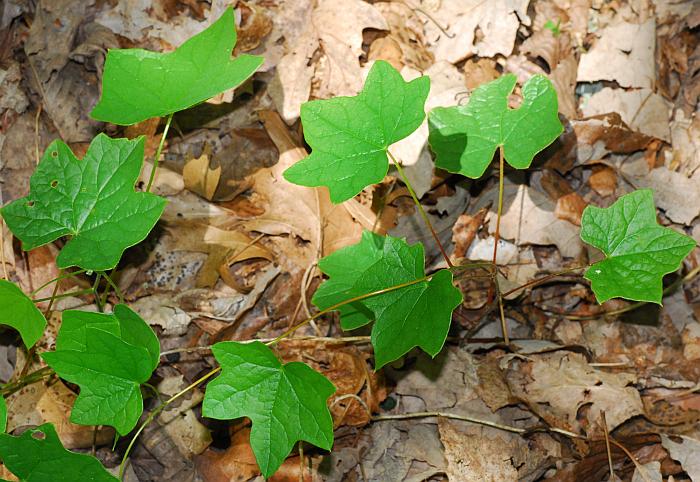Menispermum canadense L.
Moonseed

Native
CC = 4
CW = 3
MOC = 63
© SRTurner
Menispermum canadense L.Moonseed | |
 |
Native CC = 4 CW = 3 MOC = 63 |
© SRTurner |
|
Family - Menispermaceae Habit - Dioecious, perennial vine, often woody at the base, lacking tendrils and spines. Stem - Twining and climbing, to 5 m, glabrous or nearly so. Leaves - Alternate, simple, petiolate, narrowly peltate, the petiole attached to the underside of the blade near the base. Blades variable, 5-13 cm long, 6.0-17.5 cm wide, triangular to almost reniform, shallowly 5- or 7-lobed or sometimes unlobed, with 7 or 9 main veins from the attachment point of the petiole, the upper surface glabrous or sparsely to densely hairy, the undersurface sparsely to densely hairy, the base cordate, rounded to bluntly pointed at the tip or the tips of the lobes, usually with an abrupt minute sharp point at the very tip.
Inflorescences - Axillary racemes or panicles, 3-8 cm long. Bractlets absent.
Flowers - Unisexual, actinomorphic, hypogynous. Sepals 6, 1-3 mm long. Petals 4-12, shorter than the sepals. Stamens 12-36, the anthers 4-locular. Pistils 2-4.
Fruits - Globose drupes, 9-15 mm in diameter, greenish with a bloom, maturing to bluish black, the endocarp discoid, with a transversely ridged crest around the rim, both sides concave.
Flowering - May - June. Habitat - Mesic and bottomland forests, bluff bases, streambanks, roadsides, shaded disturbed areas. Origin - Native to the U.S. Lookalikes - Species of wild grape (Vitis sp., Ampelopsis cordata) Other info. - This vine is common throughout Missouri and most of the eastern half of the continental U.S., becoming scarce in the southern states. It also ranges into eastern Canada. Photographs taken at Drury-Mincy Conservation Area, Taney County, MO, 5-2-2012, Weldon Spring Conservation Area, St. Charles County, MO, 5-6-2012, Glassberg Conservation Area, Jefferson County, MO, 7-10-2017, Busch Greenway / Duckett Creek, St. Charles County, MO, 9-25-2017, and Valley View Glade Natural Area, Jefferson County, MO, 5-20-2019 (SRTurner). |